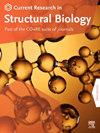利用硅技术研究参与霍乱弧菌生物膜信号传递的二胍酸环化酶的基因组学、拓扑学和结构特性:抗击霍乱的有希望的药物靶点
IF 2.7
Q3 BIOCHEMISTRY & MOLECULAR BIOLOGY
引用次数: 0
摘要
在其生命周期的各个阶段,霍乱弧菌启动生物膜信号级联。细胞间高水平的信号核苷酸3 ‘ -5 ’环二聚鸟苷单磷酸(c-di-GMP)是由二胍酸环化酶(DGCs)从其前体分子GTP合成的,对生物膜的形成至关重要。本研究旨在利用计算机方法评价霍乱弧菌6种c-二gmp调控DGCs (CdgA、CdgH、CdgK、CdgL、CdgM、VpvC)的基因组学、物理化学、拓扑结构和功能特性。基因组研究表明,密码子偏好倾向于AU端而不是GC端,总GC含量在44.6 ~ 49.5之间,密码子适应指数在0.707 ~ 0.783之间。拓扑分析揭示了所有蛋白质中跨膜结构域的存在。所有DGCs均为酸性、亲水性和耐热性。在体外条件下,只有CdgA、CdgH和VpvC是稳定的。以α-螺旋为主要二级结构的非极性氨基酸,以亮氨酸为最丰富的氨基酸,二级结构分析表明,这些非极性氨基酸负责形成跨膜区域。通过AlphaFold和trRosetta计算得到蛋白质的三级结构。使用PROCHECK、ERRAT和Modfold8服务器对两种服务器的预测结构进行了多方面的比较。使用GalaxyRefine对选定的3D结构进行细化。InterPro Scan显示在所有DGCs中存在保守的GGDEF结构域,并预测了GGDEF结构域的活性位点残基。利用CB-DOCK 2工具进行分子对接研究发现,在DGCs中,VpvC对GTP的亲和力最高(−5.6 kcal/mol),其次是CdgL(−5.5 kcal/mol)。MD模拟显示所有DGC-GTP配合物都是稳定的,因为它的特征值相当低。这些研究被认为对霍乱弧菌DGCs的基因组和结构特性提供了初步的了解,这些DGCs积极参与生物膜信号系统,预计将有助于发现新的DGC抑制剂,这些抑制剂可以靶向和下调c-di-GMP调节系统,从而开发针对霍乱病原体的抗生物膜策略。本文章由计算机程序翻译,如有差异,请以英文原文为准。

Investigations on genomic, topological and structural properties of diguanylate cyclases involved in Vibrio cholerae biofilm signalling using in silico techniques: Promising drug targets in combating cholera
During various stages of its life cycle, Vibrio cholerae initiate biofilm signalling cascade. Intercellular high level of the signalling nucleotide 3′-5′ cyclic dimeric guanosine monophosphate (c-di-GMP), synthesized by diguanylate cyclases (DGCs) from its precursor molecule GTP, is crucial for biofilm formation. Present study endeavours to in silico approaches in evaluating genomic, physicochemical, topological and functional properties of six c-di-GMP regulatory DGCs (CdgA, CdgH, CdgK, CdgL, CdgM, VpvC) of V. cholerae. Genomic investigations unveiled that codon preferences were inclined towards AU ending over GC ending codons and overall GC content ranged from 44.6 to 49.5 with codon adaptation index ranging from 0.707 to 0.783. Topological analyses deciphered the presence of transmembrane domains in all proteins. All the DGCs were acidic, hydrophilic and thermostable. Only CdgA, CdgH and VpvC were predicted to be stable during in vitro conditions. Non-polar amino acids with leucine being the most abundant amino acid among these DGCs with α-helix as the predominant secondary structure, responsible for forming the transmembrane regions by secondary structure analysis. Tertiary structures of the proteins were obtained by computation using AlphaFold and trRosetta. Predicted structures by both the servers were compared in various aspects using PROCHECK, ERRAT and Modfold8 servers. Selected 3D structures were refined using GalaxyRefine. InterPro Scan revealed presence of a conserved GGDEF domain in all DGCs and predicted the active site residues in the GGDEF domain. Molecular docking studies using CB-DOCK 2 tool revealed that among the DGCs, VpvC exhibited highest affinity for GTP (−5.6 kcal/mol), which was closely followed by CdgL (−5.5 kcal/mol). MD simulations depicted all DGC-GTP complexes to be stable due to its considerably low eigenvalues. Such studies are considered to provide maiden insights into the genomic and structural properties of V. cholerae DGCs, actively involved in biofilm signalling systems, and it is projected to be beneficial in the discovery of novel DGC inhibitors that can target and downregulate the c-di-GMP regulatory system to develop anti-biofilm strategies against the cholera pathogen.
求助全文
通过发布文献求助,成功后即可免费获取论文全文。
去求助

 求助内容:
求助内容: 应助结果提醒方式:
应助结果提醒方式:


